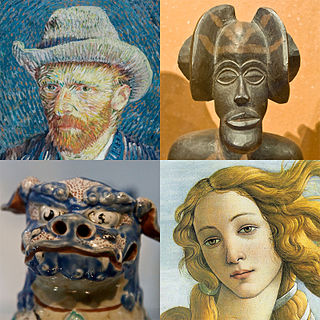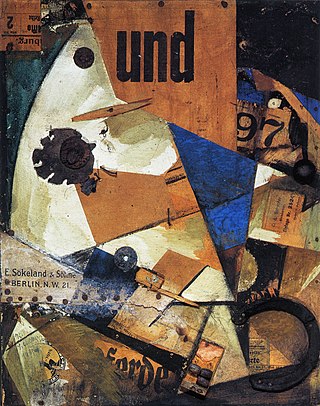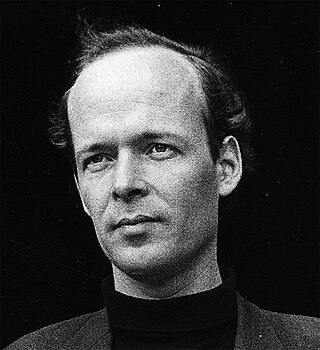
Art is a diverse range of human activity, and its resulting product, that involves creative or imaginative talent expressive of technical proficiency, beauty, emotional power, or conceptual ideas.

A concept is defined as an abstract idea. It is understood to be a fundamental building block underlying principles, thoughts and beliefs. Concepts play an important role in all aspects of cognition. As such, concepts are studied within such disciplines as linguistics, psychology, and philosophy, and these disciplines are interested in the logical and psychological structure of concepts, and how they are put together to form thoughts and sentences. The study of concepts has served as an important flagship of an emerging interdisciplinary approach, cognitive science.

Modernism is a philosophical, religious, and arts movement that arose from broad transformations in Western society during the late 19th and early 20th centuries. The movement reflected a desire for the creation of new forms of art, philosophy, and social organization which reflected the newly emerging industrial world, including features such as urbanization, architecture, new technologies, and war. Artists attempted to depart from traditional forms of art, which they considered outdated or obsolete. The poet Ezra Pound's 1934 injunction to "Make it New" was the touchstone of the movement's approach.

A found object, or found art, is art created from undisguised, but often modified, items or products that are not normally considered materials from which art is made, often because they already have a non-art function. Pablo Picasso first publicly utilized the idea when he pasted a printed image of chair caning onto his painting titled Still Life with Chair Caning (1912). Marcel Duchamp is thought to have perfected the concept several years later when he made a series of ready-mades, consisting of completely unaltered everyday objects selected by Duchamp and designated as art. The most famous example is Fountain (1917), a standard urinal purchased from a hardware store and displayed on a pedestal, resting on its side. In its strictest sense the term "ready-made" is applied exclusively to works produced by Marcel Duchamp, who borrowed the term from the clothing industry while living in New York, and especially to works dating from 1913 to 1921.
Conceptual art, also referred to as conceptualism, is art in which the concept(s) or idea(s) involved in the work are prioritized equally to or more than traditional aesthetic, technical, and material concerns. Some works of conceptual art may be constructed by anyone simply by following a set of written instructions. This method was fundamental to American artist Sol LeWitt's definition of conceptual art, one of the first to appear in print:
In conceptual art the idea or concept is the most important aspect of the work. When an artist uses a conceptual form of art, it means that all of the planning and decisions are made beforehand and the execution is a perfunctory affair. The idea becomes a machine that makes the art.

Postmodern art is a body of art movements that sought to contradict some aspects of modernism or some aspects that emerged or developed in its aftermath. In general, movements such as intermedia, installation art, conceptual art and multimedia, particularly involving video are described as postmodern.

Art & Language is an English conceptual artists' collaboration that has undergone many changes since it was created around 1967. The group was founded by artists who shared a common desire to combine intellectual ideas and concerns with the creation of art, and included many Americans.
Software art is a work of art where the creation of software, or concepts from software, play an important role; for example software applications which were created by artists and which were intended as artworks. As an artistic discipline software art has attained growing attention since the late 1990s. It is closely related to Internet art since it often relies on the Internet, most notably the World Wide Web, for dissemination and critical discussion of the works. Art festivals such as FILE Electronic Language International Festival, Transmediale (Berlin), Prix Ars Electronica (Linz) and readme have devoted considerable attention to the medium and through this have helped to bring software art to a wider audience of theorists and academics.

In visual art, mixed media describes artwork in which more than one medium or material has been employed. Assemblages, collages, and sculpture are three common examples of art using different media. Materials used to create mixed media art include, but are not limited to, paint, cloth, paper, wood and found objects.

Joseph Kosuth is an American conceptual artist, who lives in New York and London, after having resided in various cities in Europe, including Ghent and Rome.

Michael Corris is an artist, art historian and writer on art. He is professor emeritus of art, Division of Art, Meadows School of the Arts, Southern Methodist University, Dallas, Texas, United States. Previously, Corris held the post of Professor of Fine Art at the Art and Design Research Center, Sheffield Hallam University. From 2005-6, he was a Visiting Professor of Art Theory at the Bergen Art Academy.
A semantic theory of truth is a theory of truth in the philosophy of language which holds that truth is a property of sentences.
In art history, formalism is the study of art by analyzing and comparing form and style. Its discussion also includes the way objects are made and their purely visual or material aspects. In painting, formalism emphasizes compositional elements such as color, line, shape, texture, and other perceptual aspects rather than content, meaning, or the historical and social context. At its extreme, formalism in art history posits that everything necessary to comprehending a work of art is contained within the work of art. The context of the work, including the reason for its creation, the historical background, and the life of the artist, that is, its conceptual aspect is considered to be external to the artistic medium itself, and therefore of secondary importance.
In the visual arts, late modernism encompasses the overall production of most recent art made between the aftermath of World War II and the early years of the 21st century. The terminology often points to similarities between late modernism and post-modernism although there are differences. The predominant term for art produced since the 1950s is contemporary art. Not all art labelled as contemporary art is modernist or post-modern, and the broader term encompasses both artists who continue to work in modern and late modernist traditions, as well as artists who reject modernism for post-modernism or other reasons. Arthur Danto argues explicitly in After the End of Art that contemporaneity was the broader term, and that postmodern objects represent a subsector of the contemporary movement which replaced modernity and modernism, while other notable critics: Hilton Kramer, Robert C. Morgan, Kirk Varnedoe, Jean-François Lyotard and others have argued that postmodern objects are at best relative to modernist works.

Collage is a technique of art creation, primarily used in the visual arts, but in music too, by which art results from an assemblage of different forms, thus creating a new whole.

Art history is the study of aesthetic objects and visual expression in historical and stylistic context. Traditionally, the discipline of art history emphasized painting, drawing, sculpture, architecture, ceramics and decorative arts; yet today, art history examines broader aspects of visual culture, including the various visual and conceptual outcomes related to an ever-evolving definition of art. Art history encompasses the study of objects created by different cultures around the world and throughout history that convey meaning, importance or serve usefulness primarily through visual representations.

Gerhard von Graevenitz was a German kinetic artist, co-founding member of the Nouvelle Tendance and member of the op-art movement. He also belonged to the international circle of the Zero-Group. He is seen as one of the uncompromising representatives of the constructive-concrete art of the younger generation.

In information science a conceptualization is an abstract simplified view of some selected part of the world, containing the objects, concepts, and other entities that are presumed of interest for some particular purpose and the relationships between them. An explicit specification of a conceptualization is an ontology, and it may occur that a conceptualization can be realized by several distinct ontologies. An ontological commitment in describing ontological comparisons is taken to refer to that subset of elements of an ontology shared with all the others. "An ontology is language-dependent", its objects and interrelations described within the language it uses, while a conceptualization is always the same, more general, its concepts existing "independently of the language used to describe it". The relation between these terms is shown in the figure to the right.
Post-conceptual, postconceptual, post-conceptualism or postconceptualism is an art theory that builds upon the legacy of conceptual art in contemporary art, where the concept(s) or idea(s) involved in the work takes some precedence over traditional aesthetic and material concerns. The term first came into art school parlance through the influence of John Baldessari at the California Institute of the Arts in the early 1970s. The writer Eldritch Priest, specifically ties John Baldessari's piece Throwing four balls in the air to get a square from 1973 as an early example of post-conceptual art. It is now often connected to generative art and digital art production.
Gendai Bijutsu Kondankai was a study and discussion group founded in 1952 to facilitate interdisciplinary and cross-genre exchanges among Japanese artists based in the Kansai region. Among the participants were key figures of Japanese avant-garde art after World War II, such as calligraphers Shiryū Morita, Yuichi Inoue and Sōgen Eguchi, potter Yasuo Hayashi, and painters Waichi Tsutaka, Kokuta Suda, Jirō Yoshihara and future members of the Gutai Art Association. Genbi's activities, which included monthly meetings and group exhibitions, ceased in 1957.













